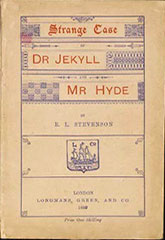Strange Case of Dr Jekyll and Mr Hyde
Critique • Quotes • Text • At the movies
 First edition
First editionFirst publication
1886
Literature form
Novella
Genres
Science fiction, horror
Writing language
English
Author's country
Scotland
Length
Approx. 24,500 words
One and a half men
The surprising thing about Robert Louis Stevenson's horror story, if you had previously known the Jekyll and Hyde character only indirectly through popular culture, is that it's so brief. Not only is the novella short enough in itself, but the narrative of that famous split personality takes up only its last quarter.
Reading Strange Case of Dr Jekyll and Mr Hyde today, we know of course that Jekyll and Hyde are the same person, in a manner of speaking. Is there anyone alive today for whom this comes as a spoiler? And yet it takes most of the novella for the figures we follow—Jekyll/Hyde's friends and colleagues—to discover this.
It is almost impossible for us in this era—when superheroes with secret identities, multiple personality disorder, personality-altering drugs, and transforming powers are cultural tokens—to realize what a shocker the concept must have been in the Victorian era when this tale was coined. And of course this story itself has become part of common reference, whenever we talk about changeable characters as being Jekylls and Hydes.
There's an interesting difference though between Stevenson's original idea and the passed-down concept of the two-faced character. In the book, counter to most movie treatments of Jekyll and Hyde, the latter is physically smaller, representing a backward undeveloped personality. The normal doctor Jekyll is the larger, more evolved being, who has progressed beyond the primitive state, while his alter ego Hyde is a regression to an earlier stage.
Hyde is more vital and primal in his appetites because he has cast off the civilizing evolution that restrains the doctor, but still he is only a partial person while Jekyll is the complete man. Unfortunately the complete man yearns to be able to indulge in the lascivious and guiltless activities of the brute within him.
When we talk about Jekyll and Hyde today, however, we generally mean a good and a bad character, each being only half of the whole, forming a kind of yin-yang complementarity. We refer to the good side and the evil side of a person.
Hollywood has generally seen the Stevenson story this way too, preferring to sell the idea in vaguely supernatural rather than evolutionary terms. Often too the story is recast as being about a scientist, led by prideful arrogance, tampering with matters that should be left to God and thereby losing his soul—as in the Frankenstein cautionary tale.
The horror of looking back
The nineteenth-century horror tale that Stevenson's Dr Jekyll and Mr Hyde is closest to, though, may be Bram Stoker's Dracula, which came out only a year later. There is, first of all, some similarity of style, with Stevenson employing multiple narrators, telling the story partly through letters and documents, as Stoker does to a greater extent.
And secondly there is, of course, the similar themes of people giving up their humanity, in the one case with the help of a drug and in the other case due to a blood infection.
Another intriguing coincidence is that both of these stories became wildly popular at a time when ideas of evolution—of species not being fixed but continually transforming—were catching on among the general public.
Both of these literary works at this time look backwards, to more feral, animal pasts, and ask how much of them is still in us.
— Eric
Critique • Quotes • Text • At the movies

